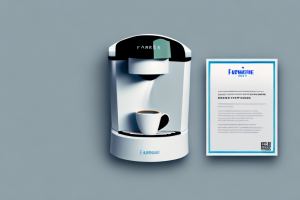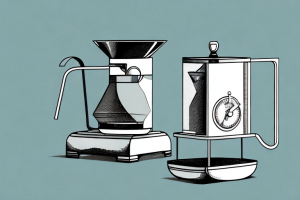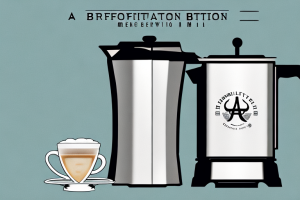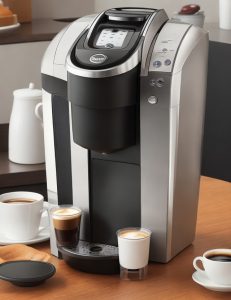Cleaning Bunn Coffee Maker

A bunn coffee maker with all its components and parts
Having a freshly brewed cup of coffee in the morning can be the perfect start to your day. Bunn coffee makers are a popular brand for brewing coffee at home, and to enjoy a consistently tasty cup, it’s important to keep it clean and well-maintained. In this article, we’re going to discuss the importance of keeping your Bunn coffee maker clean and the step-by-step process to clean it correctly.
Why cleaning your Bunn coffee maker is important
Over time, oils, minerals, and other debris can build up inside your coffee maker, affecting the quality and taste of your coffee. The build-up can also lead to the formation of bacteria, which can be a breeding ground for mold and other harmful microorganisms. Regular cleaning helps to remove these impurities and keep your coffee maker in good condition, promoting a healthier and better-tasting cup of coffee.
In addition to affecting the taste and quality of your coffee, a dirty coffee maker can also cause damage to the machine itself. The build-up of minerals and debris can clog the internal components, leading to malfunctions and even complete breakdowns. By regularly cleaning your Bunn coffee maker, you can extend its lifespan and save money on costly repairs or replacements.
Materials needed for cleaning your Bunn coffee maker
To begin cleaning your Bunn coffee maker, you’ll need the following items:
- Vinegar or descaling solution
- Water
- Soft-bristled brush
- Clean cloth
It’s important to note that the type of descaling solution you use will depend on the type of Bunn coffee maker you have. Some models require a specific type of solution, so be sure to check your user manual before purchasing a descaling solution. Additionally, it’s recommended to clean your Bunn coffee maker every three months to ensure optimal performance and longevity.
How to disassemble your Bunn coffee maker for cleaning
Firstly, make sure your coffee maker is unplugged and cooled down before cleaning. Next, remove the carafe and the filter basket. Disassemble any other removable parts, like the spray head, by unscrewing them. Use a soft-bristled brush to remove any coffee grounds or debris from the spray head, the carafe, and the filter basket before rinsing them in warm, soapy water. Wipe the exterior of the coffee maker down with a damp cloth.
After cleaning the removable parts, it’s important to clean the internal components of the coffee maker. Fill the water reservoir with equal parts of water and white vinegar and run a brewing cycle. This will help to remove any mineral buildup and sanitize the internal components. Once the brewing cycle is complete, run two cycles of plain water to rinse out any remaining vinegar.
It’s recommended to clean your Bunn coffee maker every three months to ensure optimal performance and longevity. Regular cleaning will also help to prevent any mold or bacteria growth, which can affect the taste of your coffee. By following these simple steps, you can keep your Bunn coffee maker clean and functioning properly for years to come.
The importance of descaling your Bunn coffee maker
Descaling your coffee maker is an essential part of the cleaning process. This helps to remove any mineral buildup inside the coffee maker from using tap water and hard water. Over time, these minerals collect and make their way into the coffee, leading to a change in taste and smell. Descaling can help to remove these mineral buildups and make sure your coffee tastes fresh and healthy.
It is recommended to descale your Bunn coffee maker every three months to ensure optimal performance and longevity of the machine. Neglecting to descale your coffee maker can lead to clogs and damage to the heating element, which can be costly to repair or replace. Regular descaling can also improve the efficiency of your coffee maker, as it allows the water to flow freely through the machine without any obstructions. So, make sure to add descaling to your regular cleaning routine to keep your Bunn coffee maker in top condition.
How to descale your Bunn coffee maker using vinegar or a descaling solution
Fill the coffee maker’s water tank half way with vinegar or descaling solution, then add water to fill it up. Turn on the coffee maker and let the solution run through the coffee maker. After the cleaning cycle, run plain water through the coffee maker to rinse it off. This washes any leftover solution, ensuring it doesn’t gather in the machine and alter the taste of your coffee.
It is important to descale your Bunn coffee maker regularly to ensure it continues to function properly. Over time, mineral deposits can build up in the machine, affecting the taste of your coffee and even causing damage to the coffee maker. Descaling your coffee maker helps to remove these deposits and keep your machine in good condition.
There are a variety of descaling solutions available on the market, but vinegar is a popular and affordable option. If you choose to use vinegar, make sure to use white vinegar and not apple cider vinegar, as the latter can leave a residue in your coffee maker. Additionally, it is recommended to descale your coffee maker every three to six months, depending on how often you use it.
Cleaning the exterior of your Bunn coffee maker
To keep your coffee maker looking as good as it works, clean the outside regularly. Dampen a clean cloth with warm water and wipe down the exterior surface of the coffee maker. For stubborn spots, you can add a mild detergent. Scouring pads or cleaners should not be used as they might scratch the surface of the machine, leaving behind permanent damage.
It is important to note that you should never submerge the coffee maker in water or use a hose to clean it. This can damage the electrical components of the machine and render it unusable. Additionally, make sure to unplug the coffee maker before cleaning the exterior to avoid any electrical hazards.
If you have a stainless steel coffee maker, you can use a stainless steel cleaner to keep it looking shiny and new. Simply apply the cleaner to a soft cloth and wipe down the exterior surface of the coffee maker. Be sure to follow the manufacturer’s instructions for the cleaner and avoid using any abrasive materials that could scratch the surface.
Tips for maintaining your Bunn coffee maker
- Clean the coffee maker once a month.
- Use distilled water instead of tap water if possible.
- Replace coffee filters once used to maintain hygienic conditions and helps in maintaining the taste of coffee.
- Don’t forget to clean the carafe’s lid.
Additionally, it is important to regularly descale your Bunn coffee maker to remove mineral buildup. This can be done by mixing equal parts of white vinegar and water and running it through the machine. Afterward, run a few cycles of plain water to rinse out any remaining vinegar. Descaling should be done every three to six months, depending on the hardness of your water.
Common problems with Bunn coffee makers and how to fix them
If you experience issues with your Bunn coffee maker, check if the funnel is clear and make sure to use the recommended coffee ground size. If the issue persists, you can contact the customer service team to guide you through the process of fixing your machine.
Another common problem with Bunn coffee makers is the accumulation of mineral deposits, which can affect the taste of your coffee and even damage your machine. To prevent this, it is recommended to regularly clean your coffee maker with a mixture of vinegar and water. Simply fill the water tank with a 50/50 mixture of vinegar and water, run a brewing cycle, and then run a few cycles with just water to rinse out any remaining vinegar. This will help keep your Bunn coffee maker in good condition and ensure that your coffee always tastes great.
How often should you clean your Bunn coffee maker?
We recommend cleaning your Bunn coffee maker every month for optimum performance. However, if you live in an area with hard water, you should clean it more frequently to prevent mineral build-ups. A good practice is to thoroughly clean the machine after every use and monthly descaling should be followed.
It is important to note that the type of coffee beans you use can also affect the frequency of cleaning. Oily beans tend to leave more residue in the machine, which can lead to clogs and affect the taste of your coffee. If you use oily beans, it is recommended to clean your Bunn coffee maker every two weeks.
Another factor to consider is the size of your coffee maker. If you have a larger machine that is used frequently, it may require more frequent cleaning to maintain its performance. On the other hand, if you have a smaller machine that is only used occasionally, monthly cleaning may be sufficient.
Alternative cleaning methods for your Bunn coffee maker
If you don’t want to use vinegar to descale your coffee maker, you can use citric acid or baking soda and water mixture as an alternative. Dissolve a tablespoon of citric acid or baking soda in a cup of warm water. Pour the solution into the Bunn coffee maker and run it through a cycle, after which you rinse it with clean water.
Another alternative cleaning method for your Bunn coffee maker is to use a commercial coffee maker cleaner. These cleaners are specifically designed to remove mineral buildup and other impurities from your coffee maker. Simply follow the instructions on the cleaner’s packaging to ensure that you use it correctly. It’s important to note that you should always rinse your coffee maker thoroughly with clean water after using any type of cleaner or descaling solution.
Cleaning and replacing the filter in your Bunn coffee maker
If there’s a permanent filter in your coffee maker, it needs to be cleaned after every use and replaced when it starts to show signs of wear. If the filter is reusable and made of paper, replace it after every use. Using fresh filters will give you a fresher and better coffee taste.
It’s also important to clean the coffee maker itself regularly. This can be done by running a mixture of equal parts water and vinegar through the machine, followed by a few cycles of plain water to rinse it out. This will help remove any buildup or residue that may affect the taste of your coffee. Additionally, make sure to wipe down the exterior of the coffee maker with a damp cloth to keep it looking clean and shiny.
Frequently asked questions about cleaning a Bunn coffee maker
- Q: Can I use bleach to clean my coffee maker?
- A: We do not recommend using bleach as it may affect the coffee maker’s taste, smell, and quality.
- Q: Can I use a dishwasher to wash my coffee maker?
- A: No, we do not recommend using a dishwasher to wash a coffee maker as it might damage the machine, even if it is advertised as dishwasher safe.
- Q: How can I prevent my coffee maker from developing mold?
- A: After cleaning your coffee maker, leave it to dry completely in a well-ventilated area especially after descaling to prevent any moisture buildup.
Conclusion: Enjoying a fresh cup of coffee from a clean, well-maintained Bunn coffee maker
Keeping your Bunn coffee maker clean and well-maintained is essential for getting the most out of your coffee-making experience. As you’ve now learnt, cleaning your coffee maker isn’t too difficult with regular maintenance, and your coffee will taste significantly better for it. With our step-by-step instructions, tips, and alternatives, you can keep your coffee maker in top condition and enjoy the perfect cup of coffee every day.



